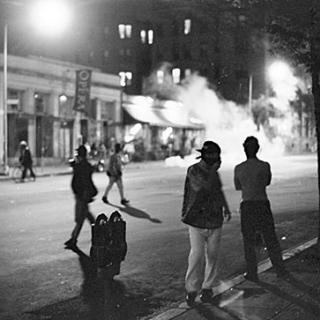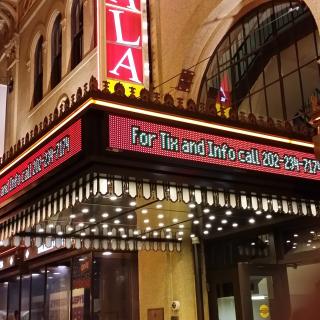Two Brothers Fled Dictatorship and Created Adams Morgan’s Most Enduring Work of Art
Three figures with wolfish grins gather around a table, red as blood. What’s on the table? Money and houses. It’s a game of Monopoly, but the people aren’t people and the game is strictly metaphorical. This image occupies the upper right quadrant of a mural located at 1817 Adams Mill Road NW in Adams Morgan. The name of the mural is “Un Pueblo Sin Murales Es Un Pueblo Desmuralizado,” which literally translates to “A People Without Murals is a Demuralized People.” But the name in Spanish is a play on words: "A People Without Murals is a Demoralized People," emphasizing the value of public art — and artistic representation — to the community. Now over forty years old, this mural is the largest, oldest and longest-standing Latinx mural in D.C.
As early as the 1950s, Adams Morgan boasted a diverse and growing community of Latin American immigrants, many of whom were fleeing oppressive regimes in their home countries. Throughout the 1970s and 1980s, many Latinx artists contributed to D.C.’s public art scene by adorning empty walls with large-scale paintings. In an Hola Cultura documentary, Dr. E. Carmen Ramos—the Associate Curator for Latino Art at the Smithsonian American Art Museum—remarks on the significance of this ephemeral art form: “Muralism is one of the most important community movements in the U.S. It began during the Civil Rights Movement. It continues to be a very important part of Chicano Art.”[1]
“Un Pueblo Sin Murales” was commissioned by Centro de Arte and devised by Renato and Carlos “Caco” Salazar in 1977. The Chilean brothers immigrated to Mount Pleasant in the mid-1970s after General Augusto Pinochet assumed dictatorship in their home country. The mural was painted in two weeks with the help of many hands. A Bolivian musician and artist, Carlos Arrien recalls: “It was just the moment. The Chilean community came first. Then we had a whole crop of Nicaraguans, then people from El Salvador. They came in waves. It was a good time.”[2] According to Arrien, the Salazar brothers came up with a creative way to foster participation, whether community members had little artistic experience or lots: the mural was pieced together by a “paint by numbers” method.[3]
The piece’s composition is alive with the sound, color, joys and tensions of Adams Morgan in the Seventies. As explained by Caco Salazar: “The flat, plain colors with thick outlines gave the figures more strength and, [like] poster art of the 70s, a more powerful view at [a] distance.”[4] The Picasso-esque figures engage in a range of activities. They walk their dogs, ride their bicycles, embrace, read books and play instruments. There are discordant elements, too. Centrally, a figure regards the television screen in terror, the aforementioned Monopoly-players bargain with real estate and a ghostly one-eyed being gives a sense that everyone (even the viewer, perhaps) is being watched. There is a fluidity between indoor and outdoor spaces, and as the eye travels across the mural, many narratives are open to interpretation.
Just as “Un Pueblo Sin Murales” transports the viewer to the era of this burgeoning artistic movement, its title also predict how the efforts of time and gentrification would attempt to undermine it.
While Adams Morgan was one of D.C.’s earliest Latinx neighborhoods, it was also one of the first to undergo gentrification, as growing rent prices drove out many residents in the mid-1980s.[5] As the fabric of the community changed, many threats to murals won over. Some were painted on plywood that deteriorated, some went down with demolished buildings, some were obscured by new high-rise apartments, and many were simply painted over.
As the oldest remaining Latinx mural in the District, “Un Pueblo Sin Murales” has overcome its fair share of threats to existence.
In 2005, the mural was faded and destined to be covered by advertisements, before the nonprofit arts and activism group Sol y Soul took on restoration efforts.[6] In an interview with The Washington Post, Enrique “Quique” Avilas, the artistic director of Sol y Soul said: “I lived around here and used to see all the murals which were in this neighborhood. As the Latino community began to disappear, so did the murals. I lived around 14th and Irving Street growing up, so when I saw the murals going away, I decided something had to be done.”[7]
With the help of organizations such as the D.C. Commission for the Arts and Humanities, the Office of Latino Affairs, and the Ludacris Foundation (founded by rapper Ludacris), Avilas helped raise the $10,000 needed to restore the mural and hired Juan Pineda to execute the necessary touch-ups. As a graffiti-inspired artist, Pineda used spray paint to refresh and modernize the mural’s original bold colors.[8]
Unfortunately, it wouldn’t be long before the mural was endangered again. When a magnitude 5.8 earthquake shook the District in August of 2011, the building sustained structural damage. Property owner Manh Phung was required to cover cracks in the wall, resulting in a web-like pattern of grey cement obstructing much of the mural. Activists were faced with an even more difficult and costly restoration project ahead. By early 2014, the District of Colombia Art Center (DCAC) received needed funding from the D.C. Commission on the Arts and Humanities, but faced another delay when unideal weather conditions persisted until spring. In April, Pineda returned to the site to complete the second restoration, finishing it over the course of a week.[9]
Half a decade later, “Un Pueblo Sin Murales” is fortunately no longer in the news. It remains a fixture at 1817 Adams Mill Road NW for the public enjoyment of passersby. As Renato Salazar claimed in 2005: “The mural has elements of Latino life which are still represented. It’s relevant because it’s demonstrative of a neighborhood which, although it has changed a lot, still has people living the same lives.”[10]
Footnotes
- ^ Hola Cultura-Hello Culture, “Muralismo DC-DC Muralism,” Vimeo, Dec 3, 2012. Video, 8:04. https://vimeo.com/54793386.
- ^ “Landmark Latino Mural in Need of Repair.” Hola Cultura, March 5, 2013, https://www.holacultura.com/landmark-latino-mural-in-need-of-repair/.
- ^ Ibid.
- ^ Jordana, “A True Adams Morgan Original.” We Love DC, July 21, 2011. http://www.welovedc.com/2011/07/21/a-true-adams-morgan-original/.
- ^ Hola Cultura, “Muralismo DC.” Vimeo.
- ^ Ibid, 10:10.
- ^ Aguilar, Chris. "For City's Latinos, the Return of a Work of Art and History: [FINAL Edition]." The Washington Post, Sep 15, 2005. https://search-proquest-com.dclibrary.idm.oclc.org/docview/409992251?accountid=46320.
- ^ Ibid.
- ^ “MURALS: The People Are No Longer “Desmuralizada.” Hola Cultura, June 11, 2014, https://www.holacultura.com/murals-the-people-are-no-longer-dismuralizado/.
- ^ Aguilar. "For City's Latinos” The Washington Post.






![Sketch of the mythical fuan by Pearson Scott Foresman. [Source: Wikipedia]](/sites/default/files/styles/crop_320x320/public/2023-10/Goatman_Wikipedia_Faun_2_%28PSF%29.png?h=64a074ff&itok=C9Qh-PE1)











